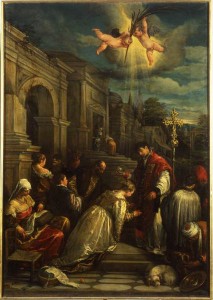The Evolution of Valentine

(Image: Saint Valentine performs a baptism, by artist Jacopo Bassano in 1575)
All the commercialization and unnecessary bitterness aside, I think Valentine’s Day is a pretty nice idea. In theory, it’s a day dedicated to spending time with the person you love most and endeavoring to show them how much you care. Sounds great!
Now, with Valentine’s Day nearly upon us, it occurred to me that Valentine’s Day is actually named for Saint Valentine, and I began to wonder, who was he? Why do we shower our significant others with love and affection and chocolate in his honor? What I found out sounded less great.
According to NPR, Valentine’s Day can be traced back to the Roman celebration of Lupercalia, meaning Wolf Festival. This celebration, which took place mid-February, included animal sacrifices, the skins of which animals would subsequently be used to whip women in the belief that doing such would make the ladies of Rome more fertile. First the men would beat the women with these animal hides, and then there would be a “matchmaking lottery,” wherein each man would draw the name of a woman who would consequently become his mate for the remainder of the celebration, or perhaps longer if the man so desired. I think we can all agree that today’s traditions of cheesy cards and overpriced jewelry are preferable to ye olde sexual and physical violence towards women and animals.
But how did we get from brutal Lupercalia to roses and sonnets? It was a two-step process.
Discovery.com tells us that the first step came in 496, when Pope Gelasius had had just about enough of the naked, rowdy, Roman ritual, and banned Lupercalia, declaring that February 14th would henceforth be recognized as St. Valentine’s Day. What remains unclear, however, is who exactly Gelasius meant for us to be honoring. You see, there were no less than three martyrs called Valentine to whom he may have been referring. One was a priest who married couples in secret, as marriage was banned during the reign of Claudius II. The second was another priest who assisted persecuted Christians, and the third was a bishop, who was tortured before being beheaded, which incidentally was the fate of all three Valentines. Talk about romantic!
NPR claims that step two, the sweetening of the holiday, is thanks to the likes of Geoffrey Chaucer and William Shakespeare, who romanticized the day. Their kinder and gentler version of the Romans’ wild sex romp of a holiday spread in popularity through Britain and then to all of Europe. Of course, the traditions came with the pilgrims over to America, and – fast forwarding just a bit – Hallmark began mass-producing greeting cards for the occasion in 1913. That being the case, this year marks the 100th birthday of Valentine’s Day as we know it! So go all out, buy one of those cards, or a box of chocolates, or even something totally ridiculous, just steer clear of the flagellation, decapitation and sacrificial death.
Sadie Rothman is the grassroots coordinator for the American Humanist Association.
